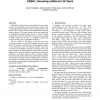Free Online Productivity Tools
i2Speak
i2Symbol
i2OCR
iTex2Img
iWeb2Print
iWeb2Shot
i2Type
iPdf2Split
iPdf2Merge
i2Bopomofo
i2Arabic
i2Style
i2Image
i2PDF
iLatex2Rtf
Sci2ools
EWSN
2016
Springer
2016
Springer
CESEL: Securing a Mote for 20 Years
Embedded wireless sensors, once deployed, may remain in active use for decades. At the same time, as motes come to dominate both the number of hosts and data traffic of the Internet, their security will become fundamental to general Internet security. This paper argues that the next generation of embedded networked sensor devices (“motes”) should consider this tension in their basic design and be designed to remain secure for 20 years in a rapidly changing and evolving security and cryptographic landscape. The key insight in this paper is that the economics of modern system-on-a-chip (SoC) designs provides ample space for hardware accelerators and cryptographic engines. A next generation mote can therefore include many such co-processors and features at almost no production cost. The paper describes an initial design for what hardware security support such a device should have, focusing on five hardware primitives: an atomic, unique counter, a random number generator based on ph...
| Added | 03 Apr 2016 |
| Updated | 03 Apr 2016 |
| Type | Journal |
| Year | 2016 |
| Where | EWSN |
| Authors | Kevin Kiningham, Mark Horowitz, Philip Levis, Dan Boneh |
Comments (0)

